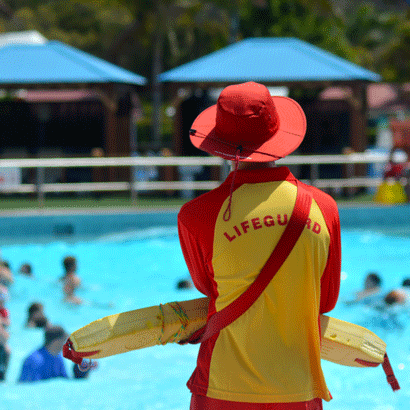
In our Spring 2022 edition of NRPA Parks Snapshot, we check on the status of park and recreation agency funding, aquatics programming, and, in particular, the hiring of lifeguards. Among the key findings from the May 4-12, 2022, survey:
Staffing
The recently released 2022 NRPA Agency Performance Review tells us that 70 percent of park and recreation agencies offer aquatics programming to their community. Most agencies expect all their indoor pools (89 percent), outdoor pools (89 percent), beaches (91 percent) and other water features (94 percent) will be open this summer season. A handful of park and recreation agencies anticipate opening some, but not all, of their indoor pools (6 percent), outdoor pools (8 percent), beaches (5 percent) and other water features (4 percent) this summer season.
While aquatics may be a year-round program at many agencies, summertime means significant seasonal lifeguard hiring. Eighty-five percent of park and recreation agencies state they currently are recruiting, interviewing and hiring summer lifeguards. As of this week, only 12 percent of park and recreation leaders indicate they are fully staffed for lifeguard positions this summer season. Nearly a third of agencies have filled 85 percent or more of open lifeguard positions. Other agencies are not as fortunate, with 39 percent of agencies having filled 51 to 84 percent of their open lifeguard positions, and 14 percent of agencies reporting more than half of their seasonal lifeguard positions are still vacant.
Four in five agency leaders note significant impacts resulting from the inability to fill open lifeguard positions. The two most frequently cited impacts are increased workload for all staff members to continue meeting aquatics needs (53 percent) and reduced/eliminated aquatics programming at their agency (47 percent). Nearly one in five agencies indicate shifting staff into unfilled aquatics positions. Additionally, many agencies state a reduction or shift in hours of operation.
Fifty-eight percent of park and recreation professionals indicate they are actively working to drive awareness of the available opportunities for hiring lifeguards and other seasonal positions. Forty-four percent of agencies have implemented paying for or discounting certifications as a hiring strategy for their seasonal positions. Additional hiring strategies include:
- On-the-job training, rather than advanced training (35 percent)
- Focus on marketing open positions to underserved communities (27 percent)
- Retention bonuses (23 percent)
- Market to retirees as a second career option (16 percent)
- Internship requirements for college (9 percent)
- Mentorship programs (6 percent)
On average, the typical park and recreation agency will be paying its lifeguards $14 per hour. Lifeguards in small metro and rural agencies are paid $13 per hour, while large metro/urban agencies pay $15 per hour.
Current and Future Budget
The majority of park and recreation operating and capital expenditure budgets match or are larger relative to pre-pandemic budgets. One-third of survey respondents state their agency's current operating budget was the same as before the pandemic. Fifty-five percent of agencies have a larger operating budget relative to the start of the pandemic (with a typical increase between 5 and 9 percent). In comparison, 12 percent of agencies’ operating budgets have contracted (with a median decline of 5 to 9 percent). There is little difference in operating expenditure budgets for agencies located in either large metro or small metro/rural locales.
A greater percentage of smaller metro and rural agencies have expanded their operating budgets. Forty-four percent of small metro and rural park and recreation agencies indicate their current operating budget is larger than before the pandemic. Thirty-one percent of large metro and urban agencies report an increased operating budget.
Forty percent of park and recreation agencies’ capital expenditure budgets have held steady relative to the pandemic’s start. Fifty-two percent of survey respondents indicate that their agency's capital expenditure budget has expanded since the start of the pandemic (with a median increase range of 10 to 19 percent). In comparison, 16 percent of agencies have seen growth in their capital expenditures budget of 20 percent or more. Nine percent of agencies have experienced a decline.
A greater percentage of smaller metro and rural agencies have expanded their capital expenditure budget. Fifty-seven percent of small metro and rural park and recreation agencies indicate their current capital budget is larger than before the pandemic. Fifty percent of large metro and urban agencies report having a larger capital budget.
The Return of Senior Center Programming
As seen in the 2022 NRPA Agency Performance Review, 41 percent of park and recreation agencies have designated senior centers and nearly four in five offer senior-targeted programming. This recent Parks Snapshot shows senior center programming is back in some capacity at those original locations. Seventy-seven percent of agencies indicate complete program offerings are available at their senior centers. The remaining 23 percent state that their senior programs are being made available with truncated offerings. Additional comments indicate virtual options remain in place, and there are challenges in staffing at these facilities and a slow return of participants.
In addition, here are highlights of the survey results from specific segments:
The survey's full results include verbatim comments shared by park and recreation leaders across the nation on their agencies’ experiences. To continue the conversation, please start a discussion on NRPA Connect.
For more information and to see results from additional surveys, visit NRPA’s Parks Snapshot Surveys webpage.
Kevin Roth (he/him) is vice president of research, evaluation and technology at NRPA.

